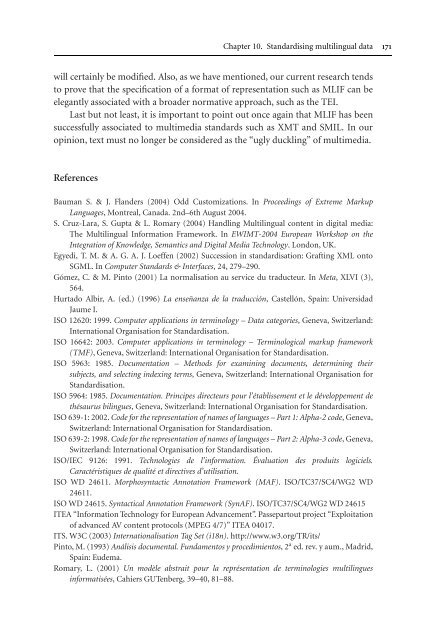Topics in Language Resources for Translation ... - ymerleksi - home
Topics in Language Resources for Translation ... - ymerleksi - home
Topics in Language Resources for Translation ... - ymerleksi - home
- No tags were found...
Create successful ePaper yourself
Turn your PDF publications into a flip-book with our unique Google optimized e-Paper software.
Chapter 10. Standardis<strong>in</strong>g multil<strong>in</strong>gual data 171will certa<strong>in</strong>ly be modified. Also, as we have mentioned, our current research tendsto prove that the specification of a <strong>for</strong>mat of representation such as MLIF can beelegantly associated with a broader normative approach, such as the TEI.Last but not least, it is important to po<strong>in</strong>t out once aga<strong>in</strong> that MLIF has beensuccessfully associated to multimedia standards such as XMT and SMIL. In ourop<strong>in</strong>ion, text must no longer be considered as the “ugly duckl<strong>in</strong>g” of multimedia.ReferencesBauman S. & J. Flanders (2004) Odd Customizations. In Proceed<strong>in</strong>gs of Extreme Markup<strong>Language</strong>s, Montreal, Canada. 2nd–6th August 2004.S. Cruz-Lara, S. Gupta & L. Romary (2004) Handl<strong>in</strong>g Multil<strong>in</strong>gual content <strong>in</strong> digital media:The Multil<strong>in</strong>gual In<strong>for</strong>mation Framework. In EWIMT-2004 European Workshop on theIntegration of Knowledge, Semantics and Digital Media Technology.London,UK.Egyedi, T. M. & A. G. A. J. Loeffen (2002) Succession <strong>in</strong> standardisation: Graft<strong>in</strong>g XML ontoSGML. In Computer Standards & Interfaces, 24, 279–290.Gómez, C. & M. P<strong>in</strong>to (2001) La normalisation au service du traducteur. In Meta, XLVI (3),564.Hurtado Albir, A. (ed.) (1996) La enseñanza de la traducción, Castellón, Spa<strong>in</strong>: UniversidadJaume I.ISO 12620: 1999. Computer applications <strong>in</strong> term<strong>in</strong>ology – Data categories, Geneva, Switzerland:International Organisation <strong>for</strong> Standardisation.ISO 16642: 2003. Computer applications <strong>in</strong> term<strong>in</strong>ology – Term<strong>in</strong>ological markup framework(TMF), Geneva, Switzerland: International Organisation <strong>for</strong> Standardisation.ISO 5963: 1985. Documentation – Methods <strong>for</strong> exam<strong>in</strong><strong>in</strong>g documents, determ<strong>in</strong><strong>in</strong>g theirsubjects, and select<strong>in</strong>g <strong>in</strong>dex<strong>in</strong>g terms, Geneva, Switzerland: International Organisation <strong>for</strong>Standardisation.ISO 5964: 1985. Documentation. Pr<strong>in</strong>cipes directeurs pour l’établissement et le développement dethésaurus bil<strong>in</strong>gues, Geneva, Switzerland: International Organisation <strong>for</strong> Standardisation.ISO 639-1: 2002. Code <strong>for</strong> the representation of names of languages – Part 1: Alpha-2 code,Geneva,Switzerland: International Organisation <strong>for</strong> Standardisation.ISO 639-2: 1998. Code <strong>for</strong> the representation of names of languages – Part 2: Alpha-3 code,Geneva,Switzerland: International Organisation <strong>for</strong> Standardisation.ISO/IEC 9126: 1991. Technologies de l’<strong>in</strong><strong>for</strong>mation. Évaluation des produits logiciels.Caractéristiques de qualité et directives d’utilisation.ISO WD 24611. Morphosyntactic Annotation Framework (MAF). ISO/TC37/SC4/WG2 WD24611.ISO WD 24615. Syntactical Annotation Framework (SynAF). ISO/TC37/SC4/WG2 WD 24615ITEA “In<strong>for</strong>mation Technology <strong>for</strong> European Advancement”. Passepartout project “Exploitationof advanced AV content protocols (MPEG 4/7)” ITEA 04017.ITS. W3C (2003) Internationalisation Tag Set (i18n). http://www.w3.org/TR/its/P<strong>in</strong>to, M. (1993) Análisis documental. Fundamentos y procedimientos,2 a ed. rev. y aum., Madrid,Spa<strong>in</strong>: Eudema.Romary, L. (2001) Un modèle abstrait pour la représentation de term<strong>in</strong>ologies multil<strong>in</strong>gues<strong>in</strong><strong>for</strong>matisées, Cahiers GUTenberg, 39–40, 81–88.
















